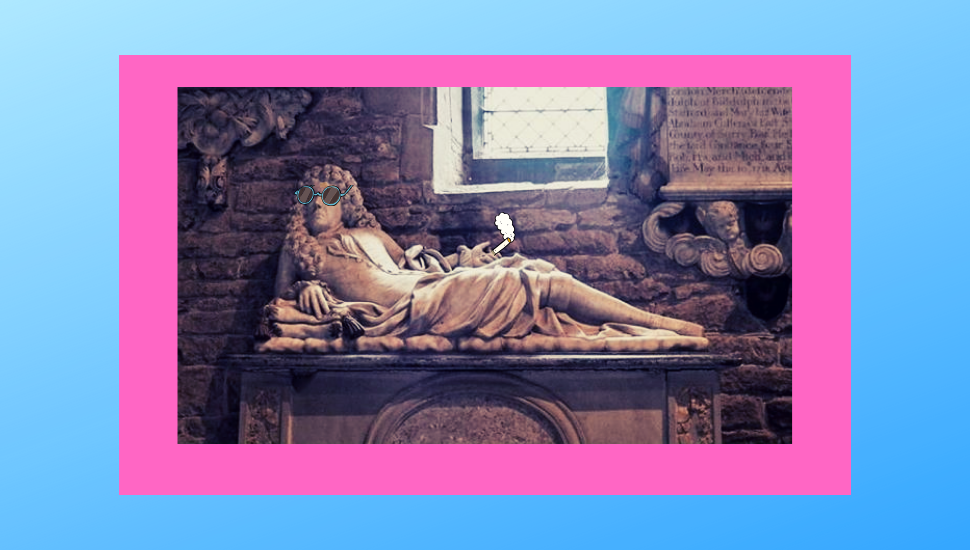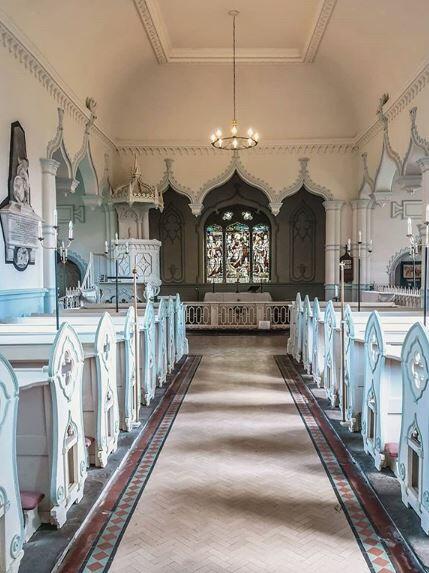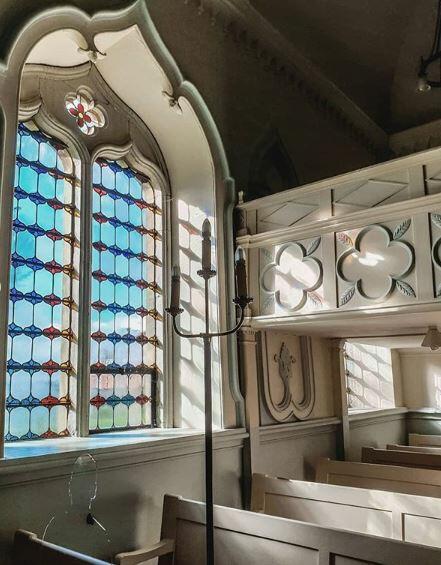
Introducing Claire Dory aka The Hisdoryan…
A self-identifying church crawler, we first fell in love with her Insta. It’s one of those accounts that treats history as a living, breathing, smiling thing, part finding-beauty-in-the-details-of-small-chapels, part Downton references. Follow it here.
A lot of her blogging on the ‘gram goes west of the border (meet, for example, the runaway lesbian Ladies of Llangollen or the Dancing Marquess - see pic, well before Pride parades) but she travels the UK, often guidebook in hand, firm in the belief that history isn’t just for the history books.

She recently wrote a great piece on Exploring Herefordshire with a John Kinross book. But we’re running her 10 Commandments piece in that hope that it’ll launch a new wave of church crawlers – or maybe just tempt you to park up and have a nose around the next time you drive by one of the dozens of gorgeous, fascinating heritage spots you can wander around for free in Herefordshire. Over to Claire:
Where do you start?
Luckily there is a whole community of enthusiastic church crawlers on hand to help. We’ve already been exploring these historic churches and chapels for years, and we’re full of tips to get you started. (A massive thank you goes to the church crawling community on Twitter for helping me form ideas for this post).
1 Thou shalt do thou research
Once you’ve identified which churches you would like to visit, step one is do your research. Yes, us historians love our research.
A rough-and-ready poll of church crawlers indicated that the Pevsner Architecural Guides series is the serious church crawlers companion of choice. The guides are a comprehensive, building-by-building look at the architecture of individual counties across the whole of the UK and are well worth investing in.
If you’re starting out I also recommend England’s Thousand Churches by Simon Jenkins. It’s a bit lighter than the Pevsner guide and thus less likely to scare off the complete beginner. If you’re church crawling in Wales, I recommend Wales’ Best One Hundred Churches by Timothy Hughes (it also covers the country’s lovely chapels).
I always enjoy using local guides too. They tend to include more local and social history, and can add a bit of colour to ‘dry’ architectural guides. For an example of such a guide, check out my recent post all about church crawling in Herefordshire.
2 Thou shalt plan, plan, plan
Prior planning is essential to any successful church crawling trip.
Start by researching the basics – when will the churches be open? Do I need to contact a keyholder in advance to gain access? Does the church still hold services and is therefore unavailable on certain days and at certain times? (ps another top tip – be super nice to key holders, they are literally the gatekeepers of churches)
And don’t forget the basic logistics. Where are you going to park? Are there public amenities nearby? A place to grab food if you don’t fancy a packed lunch?
Then double check some more. Very often the postcode for rural churches cover a wide area and might not get you straight to the front door, so its best to double check on a map before you leave (thanks to Dr Emma Wells for this top tip).
If you are travelling by car don’t forget to do some basic checks to make sure your car is roadworthy before setting off. You don’t want to break down in the middle of nowhere while searching for a very remote church. Likewise, its also very handy to have breakdown cover just in case. Oh, and dont forget you also need to know how to change your tyre – again, just in case.
When it comes to your toolkit, your camera is probably your most important item. Don’t forget to check it before you set off and CHARGE YOUR BATTERY. Carry a spare one if you can. The amount of times I have forgotten to do this! Likewise, make sure your mobile phone is fully charged, especially if you’re travelling in a rural area.
And last but not least, wear some warm clothes. Churches are cool places, even in summer.
3 Thou shalt look to the future when considering the past
Church crawling is definitely moving with the times.
The Keyholder App is a popular app for church crawlers. The app displays information for tourists and other visitors to churches in England and Wales, including opening times and keyholder information. It also allows users to make comments and add photographs, so the information is constantly kept up to date. The app also provides links to all of the major sites on the Internet which have further information about each individual church. It really is a handy thing to have on your phone!
The ‘Explore Churches’ section on the National Churches Trust website is also really handy for planning purposes. As well as a map there are regional guides and useful features like tips for taking great photos of builidings.
Recently the Churches Conservation Trust partnered with Google Arts and Culture, allowing users to access museum quality artefacts and artwork from their historic churches in online exhibitions via their convenient app. I think its a great idea and makes these churches so accessible for people who can’t get out and about.
On a basic level, just search the #churchcrawling hashtag on your chosen social media platform. This is how I got started. I particularly love Instagram for this as its so visual. I recommend following @churchcrawling and @historicenglishchurches to start. Rachel from RA Conservation has also just started a new blog devoted to the wonders of church architecture and history. Its called Tracery Tales and I totally recommend you check it out.
4 Thou shalt not forget the exterior
Okay, so you’ve made it to your first church. Before you go in, just stop and look around. People rarely spend as much time looking at the exterior of the church as they do the interior, which is a great shame.
Exteriors don’t tend to have the same level of ornamentation or decor as the interior, so its harder to hide the changes that have been made to the fabric of the building over time.You can tell so much about the history and development of a building by looking at the doors that have been closed or up the buttresses that have been added on later in the case of St Martin’s Church, Cwmyoy.
5 Thou shalt not forget the churchyard
I don’t want to sound creepy, but I love a good wonder around a graveyard.
A church is nothing without its congregation, and its people make up half the history. I also love spotting the unusual names and peculiar designs.
Very often you will find older gravestones and tombs covered with moss – A Grave Announcement recommends carrying a non abrasive-scraper for headstones.
6 Thou shalt support the church
Probably the most important church crawling commandment of them all.
The very least you can do is sign the visitor book. This is then often used by churches as evidence when applying for grants and funding.
If you can, pop a small donation in the box. Every little helps when running and maintaining these old buildings. I always purchase a guide book or leaflet too. As well as providing further support for the church, I simply love having a small souvenir of my travels.
7 Thou shalt be respectful
Don’t be afraid to move things around if you want to take a closer look at something or get that perfect shot. Just don’t forget to be VERY careful and PUT.THINGS.BACK. The bottom line is simply be respectful.
Another top tip from Graham from @gwimages_ is to always ‘lift up any spuriously positioned bits of old carpet because there’s sure as heckfire gonna be a fabulous medieval brass monument under there‘.
8 Thou shalt raise your eyes unto the ceiling
Very often the ceilings of our churches are covered in wonderful bosses. Fiona Chartres recommends carrying a pair of binoculars with you in order to get the perfect view of these architectural details, which I think is a great idea.
9 Thou shalt take it all in
Whether you’re religious or not, take a minute or two to just sit down and soak it all in.
The peace, the tranquillity, the serenity. You can’t deny churches are very spiritual places and a welcome oasis of calm in a crazy, modern world. Just a couple of quiet minutes in a pew and you’re ready to face the world again.
10 Thou shalt be part of a community
Trust me – you WILL get hooked. Church crawling is seriously addictive.
Once you’ve done your exploring and got your photos, don’t be afraid about sharing them online. Seriously, there are hundreds of people out there who really want to know more about churches in your part of the world. And you can help them!
If you’re seriously committed then I also recommend joining a charity like the Churches Conservation Trust, the National Churches Trust or Friends of Friendless Churches who do so much work in preserving these special places for future generations. I guarantee you’ll meet loads of like minded people.
I hope you’ve enjoyed my introduction to the glamorous world of church crawling. My last piece of advice would be to just go for it! I did and I’ve never looked back.
**********
Once again to read more from Claire, visit her site here or follow her on Insta here.

